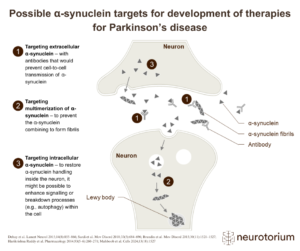Index for
slide deck
Intro

Neurobiology and aetiology
Neurobiology

Neurobiology

The motor cortex
Motor activity is controlled by projections that range from the primary motor cortex and the premotor cortical areas of the frontal lobe through to the brainstem and spinal cord.3 The primary motor cortex has an important function in the execution of distinct, well-define…

The basal ganglia
Normal motor function is the result of complex and intricate interactions between the basal ganglia, the cerebellum, and the cerebral cortex.3 The main function of the basal ganglia is to initiate motor activity and to control cortical outputs – indirectly through the tha…

The direct and indirect motor pathways
Direct motor pathway mechanism (facilitates movement)
The direct motor pathway goes from the striatum to the globus pallidus internus (GPi) via fibres that inhibit GPi activity.1,2 When this occurs, the GPi no longer inhibits the thalamus, which is now able to send an exc…

Neurotransmitters and the synapse
Cells of the nervous system communicate with each other at synapses, either via electrical signals or by the release of messenger molecules called neurotransmitters.1,2 Examples of neurotransmitters include: acetylcholine, adrenaline, dopamine, serotonin, glutamate, and h…

The role of dopamine in the brain
Dopamine is an excitatory neurotransmitter present in the neurons of several regions of the central nervous system.1,2 A major dopamine-containing area is the striatum, which plays a central role in the coordination of body movements.1,2 In addition to the striatum, dopam…
The pathogenesis of Parkinson’s disease

The pathogenesis of Parkinson’s disease

Lewy bodies
Lewy bodies are mostly comprised of abnormal, misfolded protein, and are found in the nerve cells of most patients with PD.1,4 The function of Lewy bodies in the pathogenesis of PD is still unclear, as they have been associated with both neuroprotection and toxicity.1,4 A…

α-synuclein
The protein α-synuclein was first isolated from human brain tissue during the early 1990s.10 Its role in PD only became apparent in 1997, when a mutation in the α-synuclein gene was discovered in groups of patients with a rare, autosomal dominant form of familial parkinso…

Dopaminergic cell loss in Parkinson’s disease
The overall level of atrophy of brain tissue does not seem to differ between patients with PD and age-matched controls.2 However, by the time a patient with PD develops motor symptoms, they will have suffered a moderate-to-severe loss of neuromelanin-pigmented, dopamine-p…

Braak staging of Parkinson’s disease
At a physiological level, PD is characterized by the loss of neurons in specific regions of the brain and a spreading of Lewy pathology.2 However, these do not necessarily always go together; many regions with a concentration of Lewy pathology show only mild neuronal loss…

Distribution of α-synuclein pathology in Parkinson’s disease
The Lewy pathology and aggregated α-synuclein proteins associated with PD are not confined to the central nervous system (CNS); they can also be found in the peripheral nervous system at various sites around the body, such as the skin, gastrointestinal tract, and salivary…

The gastrointestinal system and Parkinson’s disease
Neurons found in the enteric (gut) nervous system (ENS) require dopamine.1 Without dopamine, these neurons cannot properly control gastrointestinal motility.1 Animal studies have suggested that the ENS may be vulnerable to degeneration during PD, and the finding of Lewy p…

The ‘body-first’ versus the ‘brain-first’ aetiology of PD
Several lines of evidence now support the idea that there are different aetiological subtypes of PD – the body-first and the brain-first types, as outlined on the slide.1,2 In other words, the α‑synuclein pathology that characterizes PD can arise in the olfactory bulb of …































